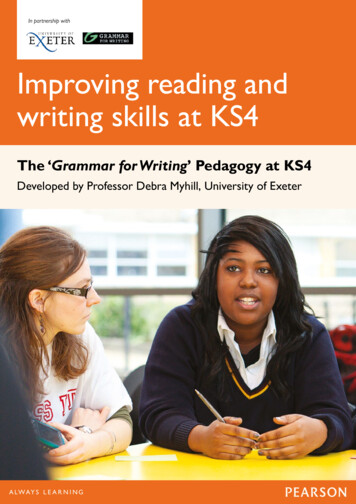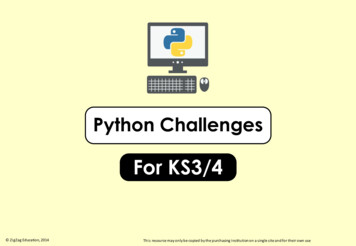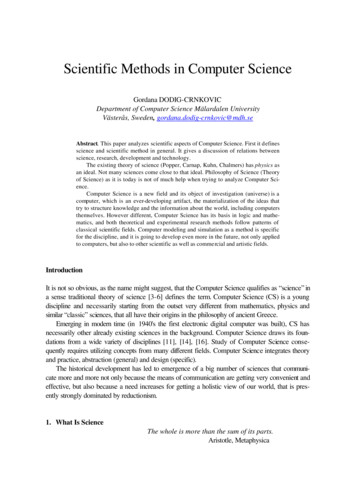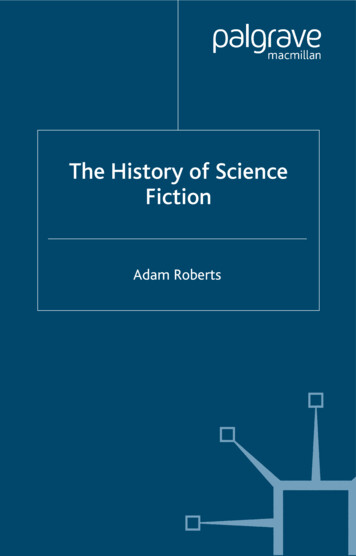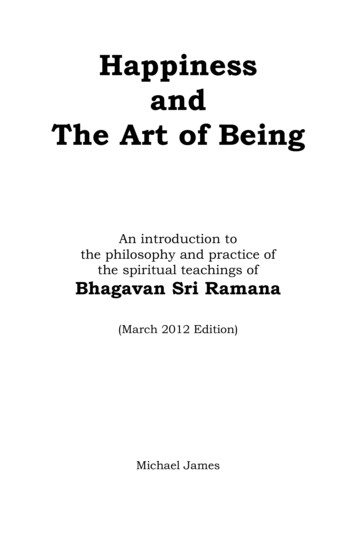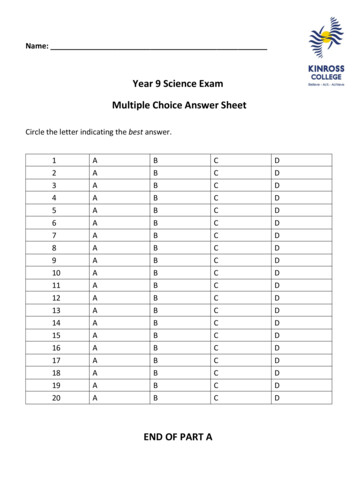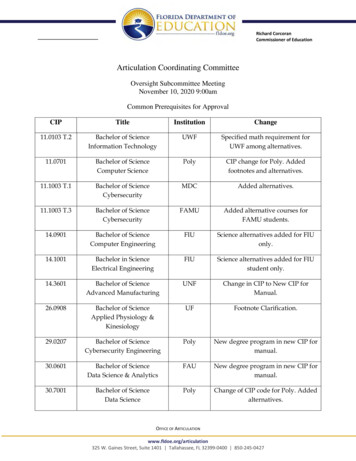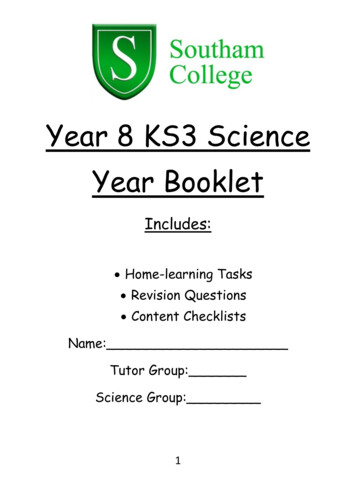
Transcription
Year 8 KS3 ScienceYear BookletIncludes: Home-learning Tasks Revision Questions Content ChecklistsName:Tutor Group:Science Group:1
Contents:Pg: 4-108B1: Health and LifestylePg: 11 - 168C1: The Periodic TablePg: 17 -258P1: Electricity and MagnetismPg: 26 -348B2: Ecosystem ProcessesPg: 35 -398C2: Separation TechniquesPg: 40 -478P2: EnergyPg: 48 - 548B3: Adaptation and InheritancePg: 55 – 608C3: Metals and AcidsPg: 61 -648P3: Motion and PressurePg: 67 - 718C4: The Earth2
FAQs.How many home-learning tasks will I need to do?One a week, which should cover 3 tasks per unit.How will I know which task to complete?Your teacher will tell you which unit and task number to complete. But youare expected to complete the challenge task for each home-learning set.What if I find the challenge task too hard?We want to challenge you to increase your progress during the year, but ifyou do find it too hard, get your tutor or a parent to make and sign a note inyour science book by your home-learning and complete the regular task. Youwill need to do this each time.What do I do if I don’t get it?Go and talk to your teacher (or any science teacher) before the due date,we are here to help. There are revision resources in this book to help,otherwise try www.bbcbitesize.co.uk or buy a revision guide from thescience lab technicians.Can I do my home-learning on the computer?Yes. But make sure you print it out and stick it in your book. If you arrive toyour lesson with it on a memory stick, it will not be accepted.Can I complete the tasks ahead of them being set?Yes! Make sure it is easy for your science teacher to find it in your bookWhat are the revision questions and checklists for?It is important to revise before each assessment. Use the checklists to findout if there are any areas you may need to work on before a test and therevision questions to get someone else or to test yourself on the topic.3
8B1: Health andLifestyleTextbook pages 4-204
8B1: Home-Learning Tasks:TaskRegularChallengeCompleted?Number1In a table list the 7 groups ofResearch what is meant bynutrients. Give an example of a food Kwashikhor. Find out why people getfrom each oneand describe why weit and the effect it has on peopleneed each nutrient.23Write a story about a day in theExplain at least two ways that thelife of a chip as it passes throughsmall intestine is adapted tothe digestive system.digestionDraw a table to show examples ofExplain how tar, nicotine and carbonmedicinal and recreational drugsmonoxide damage the breathing(including alcohol and tobacco) andsystem in humanstheir effects on the body4Summary Questions: RegularSummary Questions: ChallengeSummary Questions: Regular:1)2)3)4)5)6)List the 7 groups of food and their use in the bodyDescribe the food tests for starch, simple sugars, fats/lipids and proteinExplain the difference between a balanced diet, starvation, malnutrition and obesityDescribe the path of food through the digestive system from mouth to anusName the 3 types of enzyme and their breakdown productsDescribe the problems caused by alcohol and tobacco on the bodySummary Questions: Challenge:1) Explain why a fat free diet is not good for the body2) Is scrambled egg on toast a balanced diet? Explain your answer3) Explain why explorers in the arctic need a massive amount of food to maintain theirbody weight.4) Research the importance of bile in digestion5) Research the importance of enzymes in digestion6) Explain why drinking alcohol during pregnancy can cause damage to the foetus5
8B1: Revision Questions:Question1. Name the 7 components of a healthy diet.2. What are lipids?3. What does the body use carbohydrates for?4. What does the body use lipids for?5. What does the body use protein for?6. What does the body use vitamins and mineralsfor?7. What does the body use water for?8. What does the body use fibre for?9. What would you use to test food for starch?10. What would show starch to be present?11. How would you test solid food for lipids?12. How could you test for lipids in a solution offood?13. How do you make a solution of food?14. How do you test food for sugar?15. How do you test food for protein?16. What is the energy in food measured in?17. What is a kilojoule?18. What do we suffer if we have no food?19. What do we become if we do not eat enough?20. Give 3 problems caused by being underweight.21. What do we become if we eat too much foodor eat food too high in fat?22. What do we call someone who is extremelyoverweight?23. Give 4 problems caused by being overweight.24. What is the term for being short of a certainvitamin or mineral?25. What does a deficiency of vitamin A lead to?26. What does a vitamin D deficiency cause?27. How does more exercise affect the amount ofenergy you need?28. What happens during digestion?29. Why does digestion make large molecules intosmaller ones?AnswerCarbohydrates, Lipids, Proteins, Vitamins, Minerals, Water,Fibre.Fats and oils in food.Energy.Energy, insulation, protection of organs.Growth and repair of body tissues.Keeping you healthy in small amountsPrevention of dehydration. All cells in the body containwater.It prevents constipation by keeping the food movingthrough the digestive system.Add iodine.Iodine going a blue-black colour.Rub the solid food on a piece of filter paper and hold it upto the light. If it goes transparent, lipids are there.Add a few drops of ethanol to the solution, shake it andleave it for one minute. Tip the ethanol into water. If itgoes cloudy, lipids are there.Crush the food and mix it really well with water.Add a few drops of Benedict’s solution and then heat it in awater bath. If it goes orange-red, sugar is there.Add Buiret’s solution to the food. If it turns lilac (purple)then protein is there.Joules.1000 Joules.Starvation.Underweight.Health problems like a poor immune system, lack of energyor tiredness, lack of vitamins or minerals.Overweight.Obese.Hear t disease, stroke, diabetes, certain cancers.We call this a deficiency.Night blindness (unable to see in dim light).Rickets (weak bones).It increases it.Large molecules are broken down into smaller ones.They can then pass into the blood.6
30. Give the 7 main parts of the digestive system,in order.31. What happens in the mouth?32. What does the gullet do?33. What happens in the stomach?34. Give 2 things which happen in the smallintestine.35. What happens in the large intestine?36. What does the rectum do?37. What does the anus do?38. What are Villi?39. What is an enzyme?40. What do enzymes do in digestion?41. Name 3 enzymes.42. What does carbohydrase do?43. What does protease do?44. What does lipase do?45. What does bile do?46. What is a drug?47. What are medicinal drugs?48. What are recreational drugs?49. Name 2 legal recreational drugs.50. What is addiction?51. What is a depressant?52. What type of alcohol is in alcoholic drinks?53. What damage can alcohol cause?54. What is a stimulant?55. Give 3 health conditions caused by smoking.56. What is the name given to breathing in otherpeople’s smoke?57. What problems can be caused if a pregnantwoman smokes?58. What health problems are increased in babieswhose parents smoke?59. What sticky substance in smoke causes lungcancer?60. Name the addictive stimulant drug in tobaccosmoke.61. How does carbon monoxide in tobacco smokeaffect people?62. Give 3 diseases caused by smoking.Mouth, Gullet, Stomach, Small intestine, Large intestine,Rectum, Anus.Food is chewed and mixed with saliva.Passes food from the mouth to the anus.Food is mixed with digestive juices and acid.Digestive juices added from the liver and pancreas.Small molecules are absorbed into the blood.Water is absorbed back into the body, making faeces.Stores faeces.Allows faeces to pass out of the body.Small finger-like projections on the inside of the smallintestine which give it a bigger surface area.A biological catalyst, something which speeds up chemicalreactions without being used up.They break large molecules down into smaller ones.Carbohydrase/ amylase, Protease, Lipase.Breaks down carbohydrates such as starch down into sugarmolecules.Breaks down protein into amino acids.Breaks down lipids into fatty acids and glycerol.Helps lipase to work by breaking up lipids into smalldroplets which are easier to work on.A chemical substance which affects the way the bodyworks.Drugs which benefit health in some way.Drugs which people take for enjoyment which may harmthe body.Alcohol and tobacco.Where someone is dependent on a drug, they have to keeptaking it in order to feel normal.A drug which slows down your body’s reactions.Ethanol.Stomach ulcers, brain damage, liver damage, heart disease.A drug which speeds up the body’s reactions.Lung cancer, heart attacks, strokes.Passive smoking.Higher risk of miscarriage, low birth-weight, developmentof foetus is affected.Bronchitis, pneumonia, cot death.Tar.Nicotine.It stops the blood from carrying as much oxygen as itcould, by binding to red blood cells instead of oxygen.Heart disease, emphysema and respiratory infections.7
8B1: Checklist:Topic1.1Page4-5Spec points 1.26-7 1.38-9 1.410-11 UnderstandingI can list the contents of ahealthy human dietI can describe why parts of ahealthy human diet are neededI can give examples of foodsthat contain each nutrientI can describe what is meantby a balanced dietI can describe the foodtests for starch, lipids,sugars and proteinsI can describe the positiveresults for each nutrienttestI can explain the consequencesof imbalances in the diet(obesity, starvation anddeficiency-related diseases)I can make calculations of energyrequirements in a healthy dailydietI can name some tissues andorgans in the human digestivesystemI can describe the functions ofsome tissues and organs in thehuman digestive systemI can outline the process ofdigesting foodI can link adaptations ofdifferent parts of the digestivesystem to their functionsI can describe how food movesthrough the digestive systemI can explain how villi areadapted to their function8RevisedRP
1.512-13 1.614-15 1.716-17 1.818-19I can explain how digestionhappens, with reference toenzymesI can discuss the benefits ofbacteria in the human digestivesystemI can recall the enzymes fordifferent nutrientsI can list some effects ofrecreational drugs on behaviour,health and life processesI can describe some effects ofrecreational drugs on behaviour,health and life processesI can explain some effects ofrecreational drugs and substancemisuse on behaviour, health andlife processesI can evaluate some effects ofrecreational drugs on behaviour,health and life processesI can describe what a drug isI can list some effects ofrecreational drugs on behaviour,health and life processesI can describe some effects ofrecreational drugs on behaviour,health and life processesI can explain some effects ofrecreational drugs and substancemisuse on behaviour, health andlife processesI can evaluate some effects ofrecreational drugs on behaviour,health and life processesI can describe how we measurewhat a safe amount of alcoholis to drink I can describe what alcoholis I can describe the impact ofexercise, asthma and smoking onthe human gas exchange systemI can list, describe and explainsome effects of smoking onbehaviour, health and life 9
processesI can evaluate some effects ofrecreational drugs on behaviour,health and life processesI can describe what passivesmoking is10
8C1: The PeriodicTableTextbook pages 60-7011
8C1: Home-Learning Tasks:TaskRegularChallengeResearch the history of theFind out about some otherperiodic table. Explain how it issuggestions for laying out thearranged using the terms groups,periodic table. Evaluate how theyperiods, atomic number and atomicwere better and worse than themass.version we use.Make a poster to summarise theExtend your poster by includingreactions and properties of Group 1caesium and francium. Explain whyelements lithium, sodium, potassiumthey properties of the elementsand rubidiumchange in the groupEvaluate the uses for Helium. WhyPick an element from group 0.is using it for balloons potentially aExplain what it is used for, whereproblem for scientists?we get it from and any problemsCompleted?Number123with it.4Summary Questions: RegularSummary Questions: ChallengeSummary Questions: Regular:1. Where are the non-metals on the periodic table? – draw a diagram2. What are the groups and periods in the periodic table?3. Describe the reactions of group 1 with water?4. What are the properties of group 7 elements?5. What is unusual about group 0 elements?Summary Questions: Challenge:1.2.3.4.5.What differences are there between metals and non-metalsWhy is the pattern of the periodic table useful?What are the trends in group 1?What trends are there in group 7?What are group 0 elements used for and why?12
8C1: Revision Questions:QuestionWhere are metals on the periodic table?Where are metals on the periodic table?List three properties of a metal?List three properties of a non-metal?What is the name of an element on the borderbetween metals and non-metals?What is made when a metal reacts with oxygen?What might be made when some non-metals dissolve inrain?What are the columns of the periodic table called?What are the rows of the periodic table called?Why is it useful to understand the way the periodictable laid out?What is the pattern in melting point of group 1?What is the pattern in reactivity point of group 1?Describe the general properties of group 1What is the equation for lithium reacting with water?Are metal oxides acids or bases?What is a physical property?What are chemical properties?What the halogens?What types of compounds do fluorine, bromine andiodine make?What happens to the melting point and boiling pointdown group 7?What happens to the colours of group 7 down thegroup?What is a displacement reaction?What elements are in group 0?What is another name for group 0?What is the key chemical property of group 0elements?Where do noble gases come from?What happens when high voltages are passed throughnoble gases?13AnswerOn the leftOn the rightGood conductor of electricity, good conductor ofheat, shiny, high density, malleable, ductile,sonorousPoor conductor of electricity, poor conductor ofheat, dull, low density, brittle, not sonorousMetalloidsA metal oxideAcid rainGroup numberPeriodsTo understand the trendsDecreases down the groupIncreases down the groupLow melting and boiling points, low densities,reactiveLithium water lithium hydroxide hydrogenBasesThings you can observe and measureThey describe substances reactGroup 7Fluoride, bromide and iodideIncreasesThey get darkerA reaction where a more reactive elementreplaces a less reactive elementHe, Ne, Ar, Kr, Xe, RnNoble gasesUnreactiveUnderground or under the seaThey glow
8C1: Checklist:TopicPage1.160-61Spec points 1.262-63 UnderstandingI can state that all elementscurrently known may be foundlisted in the Periodic TableI can state that the modernPeriodic Table was developed byMendeleevI can identify where metals, nonmetals, periods and groups can befound on the Periodic TableI can list the properties of metalsand non-metalsI can describe the changes thatMendeleev made when hedeveloped the modern PeriodicTableI can describe how the propertiesof metals and non-metals makethem suitable for different usesI can explain some of theproperties of metals and nonmetals with reference to theirstructureI can explain why Mendeleev madethe changes he did whendeveloping the modern PeriodicTableI can state that the Periodic Tablecan be used to predict patterns inreactionsI can describe what groups andperiods are in the periodic tableI can state that elements in thesame group of the Periodic Tablewill have similar patterns inreactionsI can identify where metals, nonmetals, periods and groups can be14RevisedRP
1.364-65 I can predict properties ofelements from their position inthe periodic table I can identify where Group 1 isin the periodic tableI can describe the patterns ofreactivity for Group 1 in thePeriodic TableI can link group number andelectron structure to explain thepatterns of reactivity for Group 1and Group 7 in the Periodic TableI can describe the properties ofthe Group 1 elements 1.466-67 1.568-69found on the Periodic TableI can describe how elements withsimilar physical and chemicalproperties are grouped together I can describe what happenswhen Group 1 metals reactwith waterI can create word equationsfor Group 1 metals reactingwith waterI can describe the patterns ofreactivity for Group 1 and Group 7in the Periodic TableI can link group number andelectron structure to explain thepatterns of reactivity for Group 7in the Periodic TableI can describe the propertiesof Group 7 elementsI can describe what adisplacement reaction isI can write word equations fordisplacement reactionsI can identify and describethe properties of the elementsin Group 0I can describe where we canobtain Group 0 elements fromI can predict properties ofGroup 0 elements15
16
8P1: Electricityand MagnetismTextbook pages 122-13817
8P1: Home-Learning Tasks:TaskRegularChallengeDescribe 3 different problemsDescribe what Earthing isCompleted?Number1caused by static and describe 2different ways to prevent problemscaused by static electricityDescribe how static electricity isbuilt up by a moving car and explainwhy you can get a static shock whenyou touch it2Using circuit diagrams, explain whyExplain how a light dimmer switchwhen one bulb breaks in Xmas treeworks. Use a diagram to help youlights, the other lights do not turnoff.3Describe what a thermistor and aDescribe what a solenoid is. ExplainLDR do. Draw their circuit symbolshow it works and describe a use forit4Summary Questions: RegularSummary Questions: ChallengeSummary Questions: Regular:1. What are the three different types of charge?2. Draw a series circuit with two bulbs, one cell and a switch in it3. Describe what you use to measure the current in a circuit. Draw the circuit in question2 with an ammeter in it4. Describe what happens to the current in a parallel circuit5. State which 4 materials are magnetic6. Describe 3 ways to make an electromagnet strongerSummary Questions: Challenge:1. Explain how a balloon can be statically charged2. Draw a circuit with a cell and two bulbs in parallel. Add switches to the circuit so thatyou can turn each light on and off independently3. Describe what happens to the potential difference in a series and parallel circuit4. Describe what a resistor is and explain how it works5. Describe how to make an electromagnet18
19
8P1: Revision Questions:Question1. What are the 2 types of electrical charge?2. What 3 particles are atoms made from?3. What are the charges of protons, neutrons andelectrons?4. What happens when you get 2 positive charges nextto each other?5. What happens when you get a positive charge nextto a negative charge?6. What is the overall charge of an atom?7. Which particle moves when two insulating surfacesrub against each other?8. What force causes particles to move when twoinsulating surfaces rub against each other?9. What is an electric field?10. What causes lightning?11. What is a current?12. What units is current measured in?13. What equipment can you use to measure current?14. What is the symbol for a bulb, a wire, a switch anda cell?15. How can a loop of string be used to model acurrent?16.What is the job of a cell/ battery in a circuit?17. State some examples of circuit components18.What is meant by potential difference?19. What unit is potential difference measured in?20. What piece of equipment can be used to measurepotential difference?21. How do you measure the PD of a power supply?22. How do you measure the PD of a component?23. What happens to the PD in a series circuit?24.What happens to the PD in a parallel circuit?25.What happens to the current in a series circuit?26. What happens to the current in a parallel circuit?20AnswerPositive and negativeProtons, neutrons and electronsProtons positive. Neutrons 0/ neutral.Electrons negativeThey repel each otherThey attract each otherNeutralElectronsFrictionAn area around a charge where another chargewill experience a forceParticles move causing a build-up of charge. Thecharges then move causing a currentThe amount of charge flowing per secondAmpsAmmeterRope represents the charges. The amount ofrope moving per second is the currentThey push charges around the circuitBulb, buzzer, motor, resistorThe push that makes a charge move around acircuitVoltsVoltmeterConnect the voltmeter around the batteryConnect the voltmeter around the componentTotal PD of components PD of power supplyThe potential difference is the same for eachcomponent as the batteryIt is the same all the way round the circuitIt splits up at the junction
27. What is the difference between a series and aparallel circuit?28. How could you represent a parallel circuit using amodel?29. What does a resistor do? What is its symbol30. What is resistance? What is it measured in?31. What equation can be used to calculateresistance?32. What do the electrons do as they move through awire? What does this cause?33. What is meant by an electrical conductor?34. What 4 materials are magnetic?35. What are the 2 poles for a magnet?36. What happens when you get 2 different polesnext to each other?37. What happens when you get 2 similar poles next toeach other?38. What do the magnetic field lines look like around abar magnet?In series there is one loop of wire. In parallelthere is more than one loop of wire.Hold more than one loop of rope that the‘battery’ moves around at the same timeIt slows down the currentHow easy/ difficult to let the current through.Measured in OhmsResistance Potential difference CurrentThey collide with the atoms. It causes the wiresto heat up. The electrons lose energySomething that has low resistance and lets a lotof electricity through easilyIron, steel, cobalt, nickelNorth and SouthThe magnets attract each otherThe magnets repel each other39. What happens when a compass is near a magnet?40. Where is the magnetic field stronger for a barmagnet? How can you tell this?41. What else has a magnetic field?42. How is a magnetic field made?43. What shape is the magnetic field around a currentcarrying wire?They align up with the magnetic field linesAt the poles. The field lines are closer together44. What is an electromagnet?45. What do you need to make an electromagnet?46. How can you make an electromagnet stronger?A strong, electrical magnetA magnetic core with wire wrapped around itIncrease the current, PD, loops of wire wrappedaround the coreMotors, sorting out magnetic and non-magneticmetalBar magnets are permanent magnets.Electromagnets are strongerAn electronic switch containing anelectromagnetAn electrical component that spins when acurrent passes through itSomething that has high resistance and doesnotlet a lot of electricity through easily47. Name some uses for electromagnets48. Name 2 differences between bar magnets andelectromagnets49. What is a relay?50. What is a motor?31. What is an electrical insulator?21The EarthBy charges moving
8P1: ChecklistTopicPage1.1122123Spec points 1.2124125 UnderstandingI can link electrical conduction andinsulation with the structure ofatomsI can state that when twomaterials are rubbed togetherelectrons will be transferredI can describe the force betweentwo charged objects aselectrostatic forceI can describe the properties ofan electrostatic forceI can explain when objects willattract or repel each other due toelectrostatic forceI can describe how the movementof electrons can result in objectsbecoming charged with staticelectricityI can discuss some examples andapplications of static electricityI can explain how electrostaticforce may attract a non-chargedobject through the induction ofchargeI can describe what an electricfield isI can state that an electricalcircuit must be complete andinclude a power source, wires and acomponent for electricity to flowI can state that electrical currentis measured in amperes (amps)I can identify some commoncomponents of electrical circuitsfrom the circuit symbolI can give the symbol for the unitof current (A)22RevisedRP
1.3126127 1.4128129 I can name some commoncomponents of electrical circuitsI can name the component used tomeasure electrical currentI can draw the circuit symbols ofsome common components ofelectrical circuitsI can describe electrical currentas the flow of charge in a circuitI can identify electrical current asflowing from positive to negativein a solution or circuitI can describe how to correctlyconnect an ammeter to a circuitI can model an electric currentI can define the term 'directcurrent'I can state that the potentialdifference of a battery or cell iswhat causes the current to flowI can state that potentialdifference is measured in voltsI can state that a battery or cellof a higher potential differencewill cause more current to flowI can give the symbol for the unitof potential difference (V)I can name the component used tomeasure potential differenceI can describe how a bulb of anincreased potential difference willbe brighterI can describe how to correctlyconnect a voltmeter to a circuitI can model potential differenceI can state what happens to theelectric current in a series circuitI can state what happens to thepotential difference in a seriescircuitI can identify series and parallelcircuitsI can describe what happens to anelectric current at a junctionI can describe what happens tothe potential difference in a23
1.5130131 1.6132133 1.7134135 parallel circuitI can state what resistance isI can state what resistance ismeasured in and identify itssymbolI can describe what happens tothe current if the resistance isincreasedI can calculate resistance whengiven potential difference andcurrentI can discuss resistance in termsof electrical conductors andinsulatorsI can suggest some applicationsfor materials of higher or lowerresistanceI can state that magnets may betemporary or permanentI can state that like poles repeland unlike poles attractI can state that magnetism is anon-contact force that will affectmagnetic materials within themagnetic fieldI can name the three magneticmaterialsI can draw the field linessurrounding a bar magnet witharrowsI can label the north-seeking andsouth-seeking poles of a magnet,when given the field linesI can describe the Earth andcompasses as examples of magnetsI can describe the relationshipbetween: strength and distancebetween field linesI can describe how to find theshape of a magnetic field using acompassI can describe and explainattraction and repulsion in termsof the direction of field linesI can state that a flow of electriccurrent will produce a magnetic24
1.8136137 fieldI can describe temporary andpermanent magnets in terms ofhard and soft magnetic materialsI can describe how a bar magnetinside an electromagnet field canbe made to moveI can describe how to make anelectromagnetI can describe how to increase thestrength of an electromagnetI can describe how magnetism maybe inducedI can list some uses ofelectromagnetsI can describe how to make asimple motor usingelectromagnetism and a barmagnetI can describe how a relay worksand what it is used forI can list some uses of motors25
8B2: EcosystemProcessesTextbook pages 22-4026
8B2: Home-Learning Tasks:TaskRegularChallengeCompleted?Number1Using the equation for photosynthesis,Explain the importance ofdescribe where the reactants comechlorophyll, stomata and xylemfrom and what the products are usedvessels in photosynthesis.for by the plant.2Describe what you would expect aDraw a table to compareplant to look like if it was deficient inphotosynthesis anda) nitrate, b) magnesium, c)chemosynthesisphosphorus, d) potassium3Compare the equations for aerobic andExplain why anaerobic respirationanaerobic respiration and list thein yeast is economically important.similarities and differences betweenthe processes4Summary Questions: RegularSummary Questions: ChallengeSummary Questions: Regular:1) Write the word equation for photosynthesis and explain the importance of light andchlorophyll in this process2) Describe the role of the stomata in photosynthesis3) Explain why farmers add minerals to their crops4) Write the equation for aerobic respiration and describe the importance of haemoglobin inthis process5) Write down the meaning of the term interdependence. In a food web describe what couldhappen to the other organisms if one of the herbivores population decreasedSummary Questions: Challenge:1) Describe and explain the optimum (best) conditions for photosynthesis2) Explain how the palisade layer, the spongy layer and stomata in the leaf are adapted forphotosynthesis3) Explain why cropping leads to mineral deficient soils in farming but natural ecosystems rarelyshow mineral deficiency4) Compare the processes of photosynthesis, chemosynthesis and aerobic respiration5) Describe the terms predator and prey and explain how the changes in the numbers ofpredator or prey can affect the balance in an ecosystem27
8B2: Revision QuestionsQuestion1. What do producers do?2. Give 2 producers.3. Where do algae live?4. What do algae not have?5. Why are animals called consumers?6. What do we call the process whereproducers make food?7. What are the reactants inphotosynthesis?8. What are the products ofphotosynthesis?9. Give the word equation forphotosynthesis.10. Where does the energy forphotosynthesis come from?11. Which part of a leaf cell carries outphotosynthesis?12. What chemical makes chloroplastsgreen?13. Where does water enter the plant?14. What transports water through aplant?15. How does carbon dioxide enter a leaf?16. How does a leaf being thin helpphotosynthesis?17. Why do leaves have a large surfacearea?18. What do phloem tubes do?19. Where does most of the sunlight hit
Go and talk to your teacher (or any science teacher) before the due date, we are here to help. There are revision resources in this book to help, otherwise try www.bbcbitesize.co.uk or buy a revision guide from the science lab technicians. Can I do my home-learning on the computer? Yes. But make sure you print it out and stick it in your book.

